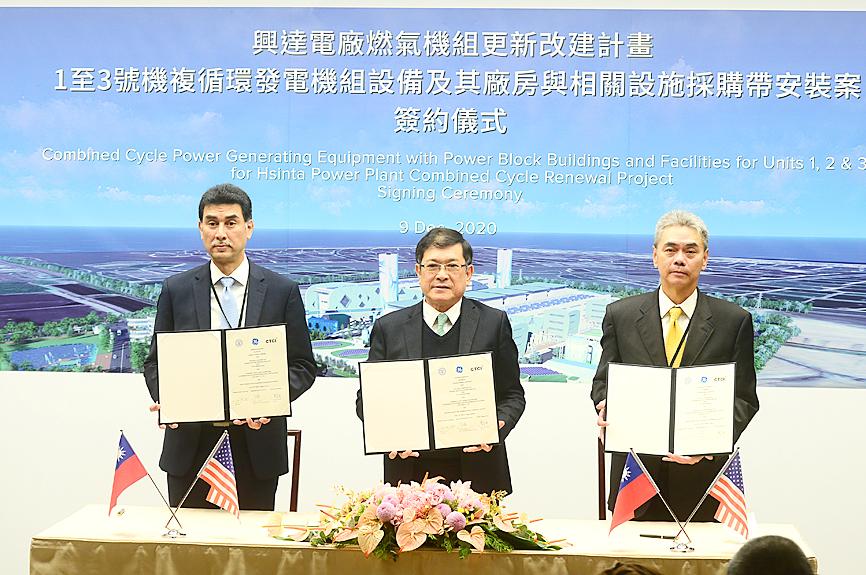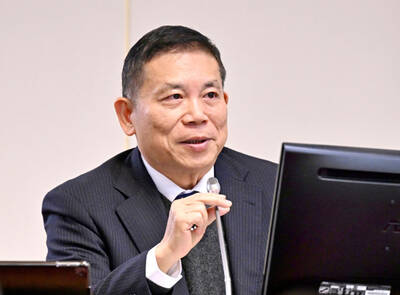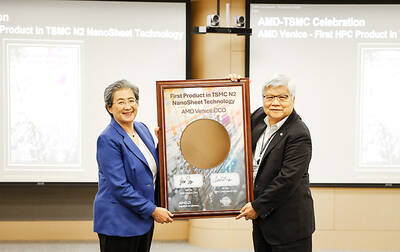Taiwan Power Co (Taipower, 台電) has purchased five new natural gas power generators from General Electric Co (GE) that would add 6.5 million kilowatts to Taiwan’s power capacity, a 16.2 percent boost, the state-run company said yesterday.
Three of the five units would be installed at the Sinda Power Plant in Kaohsiung, while two would be added to the Taichung Power Plant, Taipower said.
The combined cycle generators feature a gas turbine and a steam turbine to generate “up to 50 percent more electricity from the same fuel than a traditional simple-cycle plant,” the GE Web site said.

Photo: Wang Yi-sung, Taipei Times
A signing ceremony was held in Taipei yesterday, with the companies participating in the project represented by Taipower chairman Yang Wei-fuu (楊偉甫), GE Gas Power Asia Pacific president and CEO Ramesh Singaram and Michael Yang (楊宗興), chairman of CTCI Corp (中鼎工程), the construction partner in the projects.
“After attracting bids from manufacturers all over the world, we have chosen GE to supply our gas generator units because of their exceptional efficiency,” Yang Wei-fu said.
With costs totaling NT$100 billion (US$3.51 billion), “this is the largest natural gas generator purchase in the world in 2020,” Yang added.
“This purchase is in line with the government’s policy of increasing natural gas and decreasing coal consumption. It will also ensure future power stability while maintaining air quality,” he said.
Preparation for the installation of the units has begun at the Sinda Power Plant, with the first generator scheduled to produce electricity by 2024, with the two others at the plant projected to go online a year later, Taipower said.
However, the Taichung City Government has yet to grant permission for the two new units at the plant in the city, Yang Wei-fu said, calling on the city government to expedite the process.
“We need their help to ensure the stability of our future power supply,” he said.
The new gas-fired generators would allow the company to retire the aging No. 1 and No. 2 coal-fired generators at the Sinda Power Plant, Taipower manager Chang Ting-shu (張廷抒) said.
‘CLEANER THAN COAL’
“Comparatively speaking, natural gas is cleaner than coal,” Chang said. “We will be able to take out the oldest, dirtiest coal-burning plants while ensuring our power supply.”
There are no plans to retire coal-fired generators in Taichung, as the generators at the powerplant are newer, he said, adding that NT$9 billion has been spent to make the Taichung units “less polluting.”
“Hopefully, when the new Taichung units are up and running, we can reduce the use of the coal-fired plants, but we will keep them operational as peaker [peak-season] plants,” Chang said.
Installation of the Taichung units could be completed as early as 2024, pending approval.
“The ball is not in our court,” Chang said.

UNCERTAINTY: Innolux activated a stringent supply chain management mechanism, as it did during the COVID-19 pandemic, to ensure optimal inventory levels for customers Flat-panel display makers AUO Corp (友達) and Innolux Corp (群創) yesterday said that about 12 to 20 percent of their display business is at risk of potential US tariffs and that they would relocate production or shipment destinations to mitigate the levies’ effects. US tariffs would have a direct impact of US$200 million on AUO’s revenue, company chairman Paul Peng (彭雙浪) told reporters on the sidelines of the Touch Taiwan trade show in Taipei yesterday. That would make up about 12 percent of the company’s overall revenue. To cope with the tariff uncertainty, AUO plans to allocate its production to manufacturing facilities in

Taiwan will prioritize the development of silicon photonics by taking advantage of its strength in the semiconductor industry to build another shield to protect the local economy, National Development Council (NDC) Minister Paul Liu (劉鏡清) said yesterday. Speaking at a meeting of the legislature’s Economics Committee, Liu said Taiwan already has the artificial intelligence (AI) industry as a shield, after the semiconductor industry, to safeguard the country, and is looking at new unique fields to build more economic shields. While Taiwan will further strengthen its existing shields, over the longer term, the country is determined to focus on such potential segments as

COLLABORATION: Given Taiwan’s key position in global supply chains, the US firm is discussing strategies with local partners and clients to deal with global uncertainties Advanced Micro Devices Inc (AMD) yesterday said it is meeting with local ecosystem partners, including Taiwan Semiconductor Manufacturing Co (TSMC, 台積電), to discuss strategies, including long-term manufacturing, to navigate uncertainties such as US tariffs, as Taiwan occupies an important position in global supply chains. AMD chief executive officer Lisa Su (蘇姿丰) told reporters that Taiwan is an important part of the chip designer’s ecosystem and she is discussing with partners and customers in Taiwan to forge strong collaborations on different areas during this critical period. AMD has just become the first artificial-intelligence (AI) server chip customer of TSMC to utilize its advanced

While China’s leaders use their economic and political might to fight US President Donald Trump’s trade war “to the end,” its army of social media soldiers are embarking on a more humorous campaign online. Trump’s tariff blitz has seen Washington and Beijing impose eye-watering duties on imports from the other, fanning a standoff between the economic superpowers that has sparked global recession fears and sent markets into a tailspin. Trump says his policy is a response to years of being “ripped off” by other countries and aims to bring manufacturing to the US, forcing companies to employ US workers. However, China’s online warriors